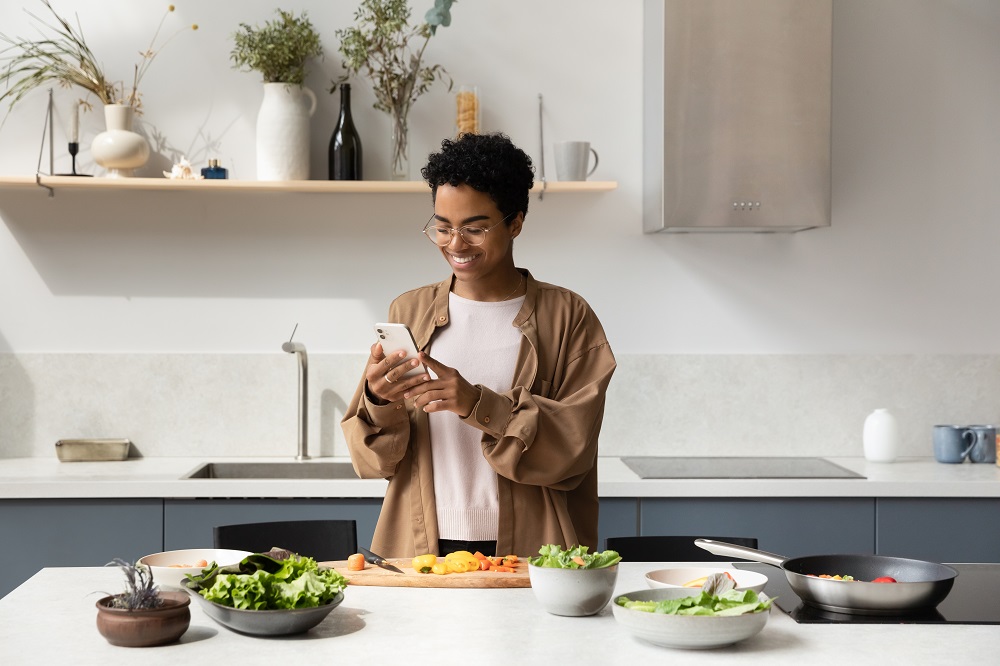
Longread
Data make digital diet truly personalised
Nutrition is a complex matter and very person-dependent. How can you combine all the scientific insights from countless studies and sources in a way that lets a layperson – or an app builder – use that information? This was a question to tackle for the Food Informatics team.
Artificial intelligence is not infallible. Even the best algorithm will not come up with the right answer if you feed it data that is wrong or badly prepared. The WUR Food Informatics team makes sure people, companies and app builders – and therefore AI systems – get the right ingredients to work with.
Pocket dietician
This is important, because we will increasingly be getting personalised nutritional advice, not just from experienced dieticians, but also in digital form from an app. In the United Kingdom and Germany alone, the market for diet and nutrition apps is set to grow by almost 20 per cent to nearly 100 million euros by 2030. That growth is partly because the userbase is changing, from fitness fanatics to lifestyle consumers.
A growing market offers a lot of opportunities for the developers of dietary and nutrition apps, and for users themselves. After all, everyone these days carries around a pocket ‘dietician’, i.e. smartphone.
In this, at the same time, lies part of the problem. The market and the offering may be changing, but so is our scientific understanding. For example, recent studies showed that saturated fats are not as unhealthy as suspected for a long while. It is also not clear whether milk really does make everyone stronger, and whether that glass of red wine is recommended or not. New studies produce new insights and knowledge, but in practice the many apps in the AppStore and Google Play don’t make use of those developments. The scientific updates don’t reach them, so they are stuck with generic, conventional recommendations that do not always have a scientific basis.

Now the project run by Wageningen Food & Biobased Research is enabling apps to be fed with the latest research results. That does not mean the scientists build apps themselves, explains Food Informatics senior researcher Mariëlle Timmer. “Not because we’re incapable of doing so – after all, we do build prototypes, such as our Fibre UP tool – but because it is not our area of expertise. A lot of design choices need to be made when building an app: what colours, what buttons and where? We are simply too expensive for that kind of work. We prefer to leave the design of the interaction with the user to professional app builders so that we can concentrate on developing the right instruments and building blocks for the app content.”
Fibre UP app
An example of such an app is the abovementioned Fibre UP (Vezel UP in Dutch), which was used in an intervention study aimed at persuading the participants – healthy people and people who suffer from irritable bowel syndrome – to eat more food rich in fibres.
The results of the study were very promising. The participating organisations able to benefit from the success included the Gelderse Vallei hospital, the Dutch Digestive Disease Foundation (MLDS) and the Dutch Bakery Centre (NBC) as well as six companies, among them the breakfast products companies Bolletje and Kellogg’s. Nearly half the participants continued using the tool after the study ended, because they liked its flexibility and its informative, positive and relaxed approach.
Building blocks apps
That success is the result of what goes on ‘under the bonnet’ of this app and others like it: data and knowledge rules, incorporated in specially developed software components. There are only a few such building blocks, but it is the way they can be combined like Lego bricks that makes them so powerful. Timmer: “For example, we started with the basic tastes of sweet, sour, salt, bitter and umami, but we know from sensory experts and food connoisseurs that there are many more flavours. That’s great, because it means we will be able to expand our toolkit.”
But it is not purely a question of taste, because the team also created building blocks that provide information about sustainability, nutrients, amino acids or the timing of meals. “The idea is that you will be able to use these forty or so building blocks to build a whole range of apps. It then depends on which building blocks – all based on scientific research – you select to put in the algorithm.” WUR can draw on “an absolute goldmine of data” for this, says Timmer. That is scientific know-how that the average app builder does not have easy access to.

It is not just flesh-and-blood app builders who will be able to use the Wageningen building blocks in the future: AI systems will also be able to benefit from them. Researcher Jan Top: “We discovered in the original study that measurements of the flavour by a special taste panel were not available for all the products. So we developed an algorithm that predicted the taste of a product by applying machine learning to products that did have a known taste profile.” That let the researchers use AI to fill in the gaps in the knowledge. Top: “If the outcome is strange, we go back to the taste experts to get their feedback. That then leads either to modifications of the algorithm or to a new study.”
Predicting the consequences of changes to a product's recipe
In addition to app builders, Top sees another important stakeholder for this development. “I think it’s an incredibly interesting tool for product developers. The personalisation of nutrition isn’t just about giving tailored advice. The tool can also be used to make products for specific target groups.” Or to predict the consequences of a change to a product’s recipe, adds Top. “At present, there is a lot of interest in replacing animal proteins with vegetable proteins, but of course that also affects the taste. Food producers want to be able to predict that effect, and our building blocks can help them do that.”
The building blocks will become increasing valuable because they form a dynamic system and the underlying data will be further enriched over the course of time. At that point, diet apps with generic nutritional recommendations will become obsolete. But the nice thing about this innovative approach to making scientific resources accessible to all is that it is always work in progress. “We are continually getting new ideas about how to make it even better,” says Timmer. “Another great aspect is that we get to work closely with domain experts. What we deliver then inspires them to come up with new options. So we still have a long way to go. In fact, you could say we have only just started!”
This article was previously published in Knowledge Base Magazine.
